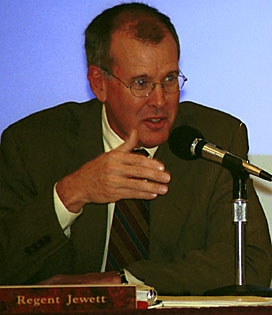 |
|
SUSIE LEMONT/Arizona Daily Wildcat
|
Regents President Jack Jewett speaks during Thursday's meeting in the Arizona Cancer Center.
|
|
By Keren G. Raz
Arizona Daily Wildcat
Monday November 25, 2002
If the Legislature cuts 5 percent of the university budget at its special session today, colleges and departments will face an average cut of 3.3 percent, President Pete Likins announced at the Arizona Board of Regents meeting Friday.
The Optical Sciences Center is getting the smallest cut of all at 2.8 percent.
A number of colleges, such as the College of Social and Behavioral Sciences are facing a 2.9 percent cut.
"We will try to be protective of colleges and departments within colleges," Likins said.
The departments of the president and vice-presidents are going to have to shoulder most of the burden of the budget cuts.
The president's office, which oversees athletics, the alumni office and the equal opportunity/affirmative action office, will be cut 10.1 percent.
Likins said he plans to cut athletics budgets by 10 percent.
The vice-president for advancement's office, which oversees offices that deal with community and government relations, will be cut 11.7 percent, the largest cut of all.
Joel Valdez, the vice-president of business affairs, who oversees university insurance, space management and student wages, will have to cut 10.1 percent from his budget.
The total of these cuts is only $16.7 million, which is the 5 percent cut the legislature told the universities to plan for earlier this month.
However, documents from the Joint Legislative Budget Committee show the size of the cut may increase to $18 million.
The Arizona Legislature is meeting today to discuss where to make cuts in the state's budget.
Likins said he is not looking at an $18 million cut because the legislature told him to prepare for a 5 percent cut.
Until the legislators make their final decision, he will only plan on cutting $16.7 million, he said.
Arizona State University President Michael Crow warned that if ASU's budget is cut one more time, administrators will have to begin eliminating programs, something that has been avoided thus far at ASU.
"There will be large-scale program elimination exercises," he said. "We will have to decide what schools and colleges we cannot afford to have anymore."
While the faculty has felt the loss in state funding for years, the students are just beginning to feel it, Likins said. Students cannot get into the courses that used to be available.
Administrators have cut 231 class sections over the past two years.
"This is the reality at the moment. We just have to look to the future," Likins said.
For most of the meeting, the regents and the presidents tried to look toward a very different future that merges universities and business together to encourage university enterprise.
This theme of enterprise has been surfacing more and more as regents and presidents try to find alternative sources of revenue for the universities.
At the meeting, Crow, Likins, and Northern Arizona University President John Haeger all expressed support for allowing university researchers to form their own companies based on research they do on campus.
Although the regents only discussed lifting limitations that restrict the geographic area in which a university can serve students, plans are already being made for the UA to extend its borders into downtown Phoenix.
Likins asked the regents on Friday to pay the debt-service for the relocation of the Arizona Health Sciences Center Phoenix Campus, which he said will be the medical center for Maricopa County and central and northern Arizona.
"The metropolitan Phoenix area is greatly disadvantaged by a lack of a medical school," Crow said. "Movement to work with UA can improve the quality of life."
As part of turning the UA into more of an enterprise that brings in outside dollars, Likins asked for the regents to approve a legislative request for increased funding of debt-service for buildings such as the Biomedical Sciences and the Biotechnology building, the AHSC Phoenix Campus Relocation, the Medical Research building, Chemistry building expansion, and the Arizona State Museum renovation and expansion.
By asking the legislature to pay for the debt service, Likins wants to free up money to use elsewhere on campus, and he wants to increase UA's ability to generate research grants.
However, he said he knows he is setting his hopes high with his request because the legislature is unlikely to give him money.
"I'm not going to count on the state providing funds to pay the debt-service," Likins said. "But that will not stop us dead in the water, it will just slow us down."

